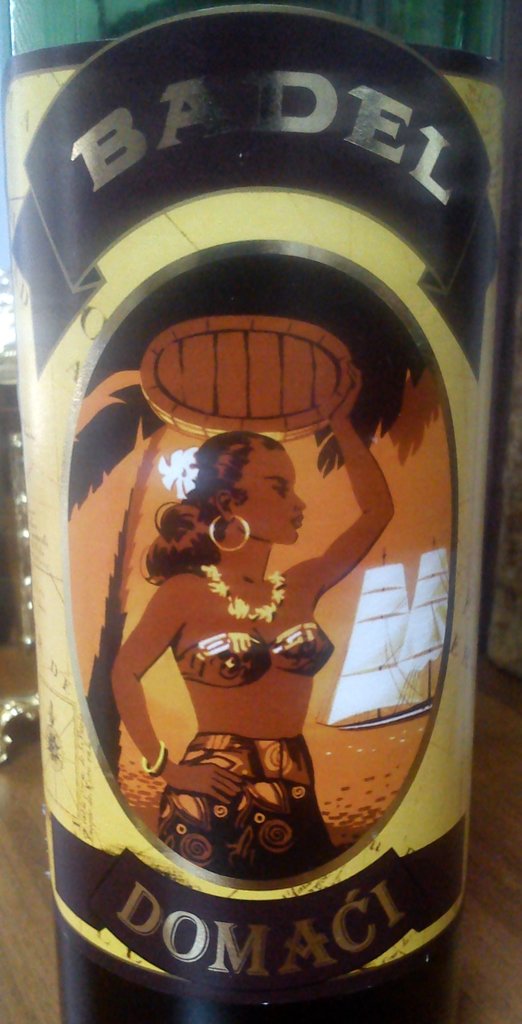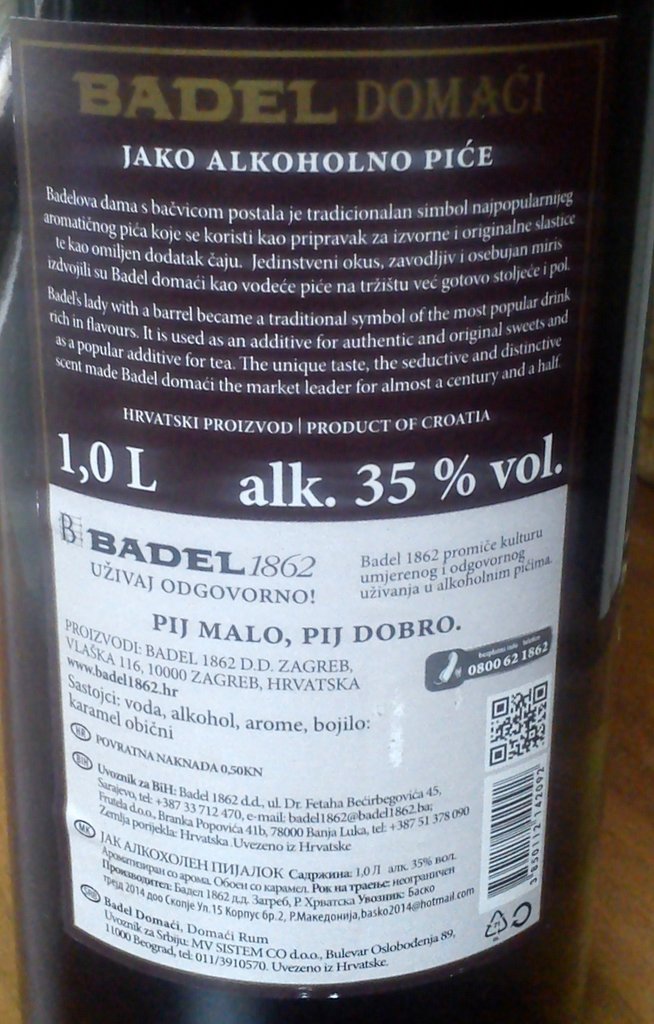
It’s been a long time since I’ve bothered to review a rum that isn’t – the Stroh comes to mind, the Czech Tuzemak, or the Mekhong from Thailand. I don’t really mind – these things are lonely, and need a home, need a review, so why not with us? It should also be noted that this product from Eastern Europe is not meant to be a drinking spirit, but one to add to teas and used in cooking, almost unknown outside the Balkans.
The Domaci – the “c” is pronounced “ch” and the word means “Domestic” – is not a spiced rum (i.e.,a rum with spices added), more like the reverse: a spiced concoction of some kind that has rum (or an essence of rum, whatever that might be) added to it. The Ultimate Rum Guide remarks it is “a spirit based on a special recipe and flavored with an extract of Rum. Its amazing aroma makes it a popular addition to many dishes.” Yeah, okay. If it was a German thing I’d call it an inländer rum, or verschnitt.
Badel 1862, the company that makes it, is an alcoholic beverages company formed in the waning days of the Austro-Hungarian empire, headquartered in Zagreb (Croatia) and still chugging along, they make mostly regional spirits like brandies, vodkas and gins, while simultaneously acting as a distributor for international brands like Bacardi. As part of the approval for their accession to the EU, they had to rename many of the spirits they were making which were not genuine: “rum” had to be changed to “room” and brandy became “bratsky;” so this provides a convenient dating regime – if your bottle says “room” then it was made after 2013. This one says “rum”, so it was made before.
 Unsurprisingly it’s mostly for sale in the Balkans — Bosnia-Herzegovina, Croatia, Serbia, with outliers in Germany — and has made exactly zero impact on the greater rum drinking public in the West. Wes briefly touched on it with a review of another Croatian product, the Maraska “Room” (similar issues with naming — the EU declined to allow it to be called “rum”), but both the Maraska and the Badel are made the same way. Since I knew none of this when initially tasting the thing, all I was aware of was its puling strength (35%) and its colour (yellow) and went on from there.
Unsurprisingly it’s mostly for sale in the Balkans — Bosnia-Herzegovina, Croatia, Serbia, with outliers in Germany — and has made exactly zero impact on the greater rum drinking public in the West. Wes briefly touched on it with a review of another Croatian product, the Maraska “Room” (similar issues with naming — the EU declined to allow it to be called “rum”), but both the Maraska and the Badel are made the same way. Since I knew none of this when initially tasting the thing, all I was aware of was its puling strength (35%) and its colour (yellow) and went on from there.
Nose first. Nope, not my cup of tea. It reminded me of an eggnog Grandma Caner had made for me once, chock full of ethanol, nutmeg, cumin and cinnamon. Also sour cream, strawberries, green grapes, and a raft sweet breakfast spices tossed in with the casual abandon of a louche rake distributing his questionable favours. It smelled thin and sweet and lacked any kind of “rumminess” altogether.
Palate? No relief here for the rumistas, though plenty of joy for the sweet toothed. I mean, anyone with even a bit of experience with rums would see that it’s a doctored mess thrown like bread to the masses who know no better, and lasting long enough (over a hundred years, remember) to become a local institution defended with becoming zealotry as “traditional”. Ethanol, soda pop, fantas and again, bags and bags of spices (nutmeg, cloves and cinnamon for the most part). Vague, meek and mild, with the slightest twinge of sharpness, leading to a short, light and fruity finish of no real distinction
I wrote rather impatiently in my notes “Weak nonsense…but okay, it’s not meant to be a rum, right?” Maybe, but that might let this local Eastern European plonk off the hook. It used to be called rum, was noted as being domestic, but frankly, they should have named it something else entirely, created its own unique category, rather than associate it with a more rigorously defined spirit with a long tradition of its own.
There are 40% and 60% variations of this thing floating around and one day if I’m in the neighborhood I might try them. The important thing is that I know what it is, and by writing this essay and you reading it, now, so do you. Feel free to try it if it ever crosses your path, but know what it is you’re getting, and what it’s good for.
(#686)(65/100)
I’ve only seen it used in baking (I guess unless one’s really desparate). And I think this spice-heavy infusion does work rather well there, at least in the local recipies. Not really drinkable though. But I wouldn’t skip it when making some fritule for the holidays ^^
You’re probably right. Most such spiced and added-to domestic rums had or have that function (incuding the Austrian Stroh). I like finding them and checking them out nevertheless, however … they add to the richness of the rum world.